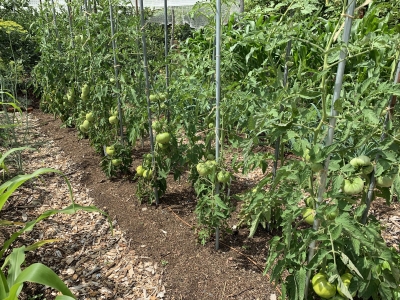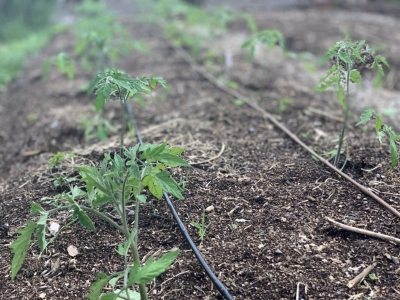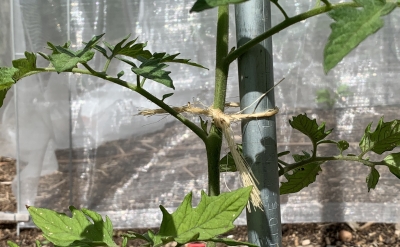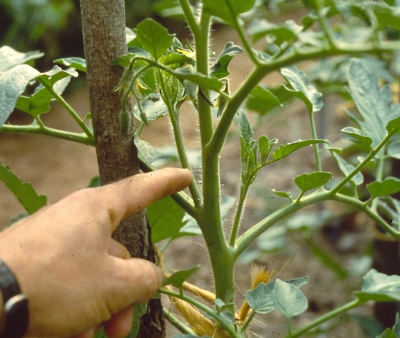REGIMENTING TOMATOES
What’s Better: Loosy Goosy or Soldier Straight?
I wonder how much our gardens reflect our personalities? Some gardeners clip their yew bushes “plumb and square;” other gardeners clip or shear away at their plants more haphazardly. Even in the vegetable patch, a temperament may be reflected in the way tomatoes are grown: Do the plants sprawl over the ground with abandon, are they contained within strings woven up and down the row, or are they neatly staked? (Woven tomatoes or those grown in wire cages are more or less sprawling plants, held aloft.)
Whatever your temperament, a good case can be made for staking tomatoes. Tomatoes on a staked plant are larger and ripen earlier than those on a sprawling plant. Good air circulation around leaves and fruits of upright plants lessens disease problems. And fruits held high above the ground also are free from dirt and slug bites. You’ll harvest less fruit from each staked plant, but since staking makes best use of the third dimension, up, staked plants can be set as close as eighteen inches apart. So staking gives the best yields per square foot — especially important in small gardens.
Flavor Picks
Tomato varieties suitable for staking are so-called “indeterminate” types, which form fruit clusters at intervals along their ever-elongating stems. “Determinate” varieties, in contrast, bearsfruits at the ends of their branches, so if a plant was pruned for staking would be reduced to a single short stem capped by a single cluster of fruits. Seed catalogues and packets usually indicate which varieties are suitable for staking.
Determinate varieties are bushy plants that need little regimenting. They also ripen their fruits within a shorter window of time.
So what’s not to like about determinate varieties? Flavor! With fewer leaves per fruit than indeterminate varieties, flavor suffers. That concentrated ripening period also can stress the plants, making them more prone to disease.
As you might guess, I grow only indeterminate varieties of tomatoes. Flavor is my main criterion in selecting a variety to grow.
Staking
When choosing a suitable stake for staking (indeterminate, of course) tomato plants, don’t be misled by the puniness of tomato transplants. A tomato stake needs to be be six to eight feet long and metal or at least one by two inches thick if made of wood. I use EMT (electrical metallic tubing) conduit, 5/8 inch diameter and 10 feet long, cut down to 7 feet. It’s easy to pound into the ground (okay, I’ll admit that here on the floodplain there are no rocks), easy to remove, and reusable for years and years.
Most books and other sources of information suggest “planting” your stake along with your tomato plant to avoid root damage later on. Not true. My established tomato plants never bat an eyelash (figuratively speaking) as I pound in metal stakes only a couple of inches from their stems. And there’s a good reason to wait until the plants are well-established; by then, chance of cold damage is reliably history. Early planted stakes would interfere with my trying to throw a protective blanket over a row of staked tomatoes should cold threaten.
With the base of a stake set a couple of inches from a plant and a 3 foot length of iron pipe, capped at one end and slid over the conduit’s free end, the stake pounds in easily with repeated lifting and forcefully lowering.
Indeterminate tomatoes are vines, but not vines that can climb by themselves. So they need to be tied to their stakes. Material for ties should be strong enough to hold the plants the whole season, and bulky enough so as not to cut into plants’ stems. Coarse twine or cotton rags, torn into strips, are good materials. I use sisal binder twine.
The usual recommendation, when tying, is to first tie a knot around the stake tightly enough to prevent downward slipping, then use the free ends of the rag strip or twine to tie a loose loop around the plant’s stem. False! With every foot or so of growth, I tie a single loop loosely around stem and stake above a node; the string can’t slip down lower than the node.
Pruning
Now for the pruning: Confine each plant to a single stem by removing all suckers, ideally before any are an inch long. A sucker is a shoot that grows from a bud originating at the juncture of a leaf and the main stem.
Go over your plants at least weekly, using your fingers to snap off each side shoot. (Cutting the shoots with a knife or pruning shear may transmit disease between plants as a blade touches cut surfaces.) Occasionally step back and refocus your eyes on the plant as a whole; I find that I sometimes overlook a sucker that has snuck up with two feet of growth I missed as I focussed on still small shoots just appearing from buds.
One final bit of pruning that some gardeners practice is to pinch out the growing tip of the plant when the stem reaches the top of the stake, then continue to remove any new leaves or flowers that form. This is a little chancy, since the effect depends on the maturity of a plant’s leaves and fruits. At worst, you reduce yield to a few clusters of fruit. But at best, your tomatoes are even earlier and larger. It may be worth a try on a couple of plants.
How do your tomatoes grow, up or sprawling. A case can be made for “up.” But you need the right variety, stake, and method of pruning.


Interesting post. I’ve been using cages for more than 20 years once I read yield was higher. I’ve tried pruning suckers but never keep up with it, so I give up early in the season. I can say we get more tomatoes than we can use, and for very little effort, but that doesn’t give a comparative yield. I prefer the appearance of staked tomatoes, though.
To help reduce disease, we mulch heavily (soil-based pathogens won’t splash up to the leaves) and we never water the leaves, although mother nature does plenty of that. And we plant them in the same bed for no more than 3 consecutive years.
I do wonder about your covering them for frost. I remember reading a few years ago that tomatoes should be planted after the soil reaches a certain temp (the # escapes me), which should occur well after any frost, I think. (Planting in cooler soil stunts the plant all season. )
There’s lots of ways to skin a cat; your method is good also. I assume you meant that you wait 3 years before planting tomatoes again in the same bed. That would be the recommendation.
As far as frost, the last frost date is an average. Some years, frost will not read the books and will arrive after that date. Same with soil temperature. Just because the soil has warmed does not mean that a frost cannot occur.
I’m also a cage person, zero-pruning, no watering, and my yields are adequate enough (between 15-25 lbs. per plant with the largest varieties producing the lowest yields).
Re: rotation, someone on GQT, I believe, mentioned a study in which yields were actually higher from tomatoes that had been planted in the same location year after year (I believe the duration of the trial was 5 years) than ones that had been planted in soil that didn’t have tomatoes (peppers or eggplants) grown in it the previous two years.
If I can locate the episode and/or study, I’ll post it.
I wonder if there’s something to that. Obviously, some soil diseases can be problematic for years, but absent one of them, I wonder if beneficial organism of some sort build up in the soil if there’s no rotation. It seems like our knowledge in that area is relatively new and not very deep.
90% of my summer garden is peppers, eggplants, and tomatoes, so rotation isn’t practical, but I haven’t had any problems. The deviation in yield isn’t significant and, I suspect, is largely a product of weather.
Rotation just lowers the chances of getting disease, which is not to say that if you don’t rotate, you get soil diseases. I’d be VERY interested in seeing that study.
I let mine sprawl upward in rectangular cages. When they reach the top of the first cage I stick another one on top. I also don’t prune the suckers but I usually only grow a few cherry tomatoes so size is less important and since I’m the only one in the family who eats them there are always enough. I do arrange the branches and sometimes prune to increase airflow.
Lee A friend of mine gave me a tomato plant called patio tomato plant. The leaves seem thicker and stronger than other varieties of tomatoes. Can you give any thoughts about patio tomatoes?
John n novi
Chefjohnnovi@gmail.com
Bad flavor
I like my paste tomatoes to ripen roughly at the same time. That way there are several to work with. When they ripen one or two here and there, it is too difficult to use them for a salsa or paste or to preserve. The cherries and slicers are indeterminates.
True, but the flavor . . . My favorite paste, and the favorite of many people, is San Marzano, an indeterminate.
We never pruned our plants & “suckers” are only on the main stem at ground level. The plant in the picture has limbs, just like a pepper plant.
Interesting, but I don’t see a photo.
Hi Lee,
Thanks for the info. Do you grow Japanese black trifle? It says indeterminate but mine are very easy to control with cages……I have to grow in raised beds with gopher wire. Anyway, JBT’s are delicious, with a delicate texture.
Susan
Never heard of it.
Now I’m laughing at myself. We used to rotate annually until either my wife or I read (clearly misread) the 3-year thing. For the past 6 years we’ve followed the wrong rotation (3:yrs in 1 bed; 3 in another). That may explain why last summer was so bad for our tomatoes: no disease but small yield.
I’m just glad this summer is a new bed. Otherwise I’d be digging them up this weekend
Hi! I am wondering if you can describe the different pruning needs of determinate vs indeterminate tomatoes. Nothing is worse than a random google. Im a Sicilian living in the Hudson Valley and just have to have my sauce tomatoes. Thank you!
Hi Maria, Check out my June 8, 2022 blog post. That should answer you questions.